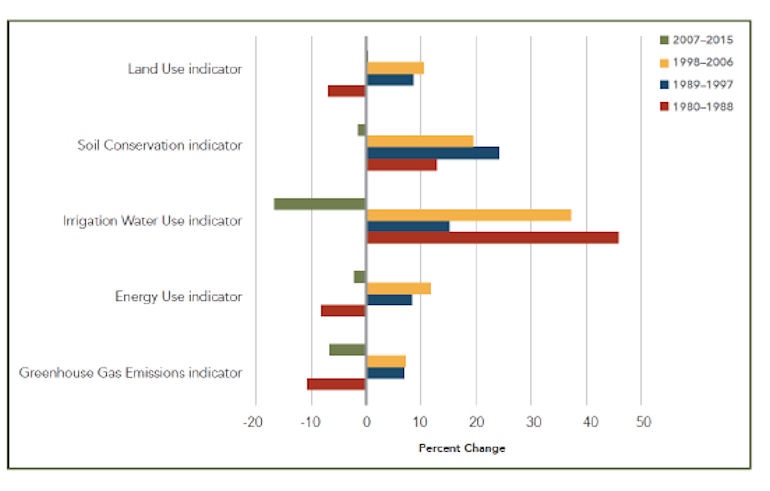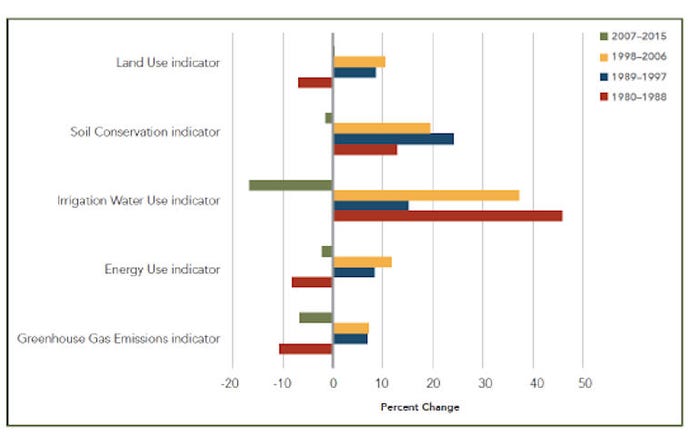Field to Market report highlights sustainability trends and calls for collective action to drive continued improvements.
December 8, 2016

Commodity crop production in the U.S. continues to demonstrate improved environmental outcomes in energy use efficiency, irrigation water use efficiency, greenhouse gas emissions, land use efficiency and soil conservation, while opportunities exist for key advancements into the future. On the whole, major U.S. crops have produced greater yields on less land, with improved environmental outcomes on a per-unit-of-production basis, according to the new report from Field to Market: The Alliance for Sustainable Agriculture.

Corn for grain improved resource efficiency with declines in per bushel land use (-41%), irrigation water use (-46%), energy use (-41%), and greenhouse gas emissions (-31%) and improvements in soil conservation (tons of soil loss per acre) (-58%).
The third edition of "Environmental & Socioeconomic Indicators for Measuring Outcomes of On-Farm Agricultural Production in the United States" (2016 National Indicators Report) analyzes eight environmental indicators and five socioeconomic indicators for 10 crops — barley, corn for grain, corn for silage, cotton, peanuts, potatoes, rice, soybeans, sugar beets and wheat — over a 36-year period at a national level.
“The sustainability of commodity crop production is a complex topic with a multidimensional set of environmental and socioeconomic variables influencing outcomes,” explained Allison Thomson, science and research director at Field to Market and lead author of the report. “By bringing together the best available data and science, in addition to input from a diverse group of experts, Field to Market seeks to provide a comprehensive picture of U.S. agriculture’s sustainability performance over the past three-and-a-half decades through a science-driven, outcomes-based approach.”
However, the report also highlights that long-term improvements are plateauing for several crops within the past 5-10 years, presenting both a challenge and opportunity for the food and agriculture industry. This underscores the critical need for continued conservation investments, research, technological development and collective action from farmers and the food and agricultural supply chain to ensure continued improvements on challenging and pressing sustainability concerns.
“At the core of these sustainability trends and improvements are millions of individual decisions made by farmers and land managers each day. By analyzing the aggregate impact of these decisions, this report underscores the critical role that farmers play in achieving improvements and delivering sustainable outcomes for agriculture and the environment,” Rod Snyder, president of Field to Market, noted.
Identifying important technology improvements that can address these environmental sustainability outcomes is one area to target. Another is further research on effective conservation practices and the necessary infrastructure, training and knowledge transfer to increase their adoption by farmers across the country.
In some areas, achieving continuous improvement is also limited by knowledge gaps that require redoubling efforts on scientific research. In particular, better understanding the fate of nutrients and the most effective practices for ensuring efficient use and minimal loss of nutrients to the environment is critical. While studies indicate the potential for water quality improvement due to conservation practice adoption is substantial, this improvement has not been observed in the nation’s waterways, the report stated.
Still, Snyder said, “there is more to be done; we recognize that this national assessment provides an opportunity to focus the efforts of the food and agricultural value chain to drive improvements where they are needed most. Field to Market remains committed to providing practical tools and resources underpinned by science-based metrics to help farmers and the supply chain continue to identify opportunities for improvements at the field and landscape level."
In addition to assessing sustainability performance by crop, the 2016 National Indicators Report also includes, for the first time, a national trends analysis for biodiversity, soil carbon and water quality. Due to lack of sufficient data and the nature of these environmental outcomes, it is not possible to calculate a national trend line by respective crop. The report shows that while limited trends can be discerned from available reports and scientific literature, translating these trends into actionable insights would require additional data and advances in scientific research. This edition of the report also provides an update on socioeconomic trends analyzed in previous editions.
For more information on the report’s findings or to explore specific crops or indicators in greater detail, visit: www.fieldtomarket.org/report.
You May Also Like

.png?width=300&auto=webp&quality=80&disable=upscale)

